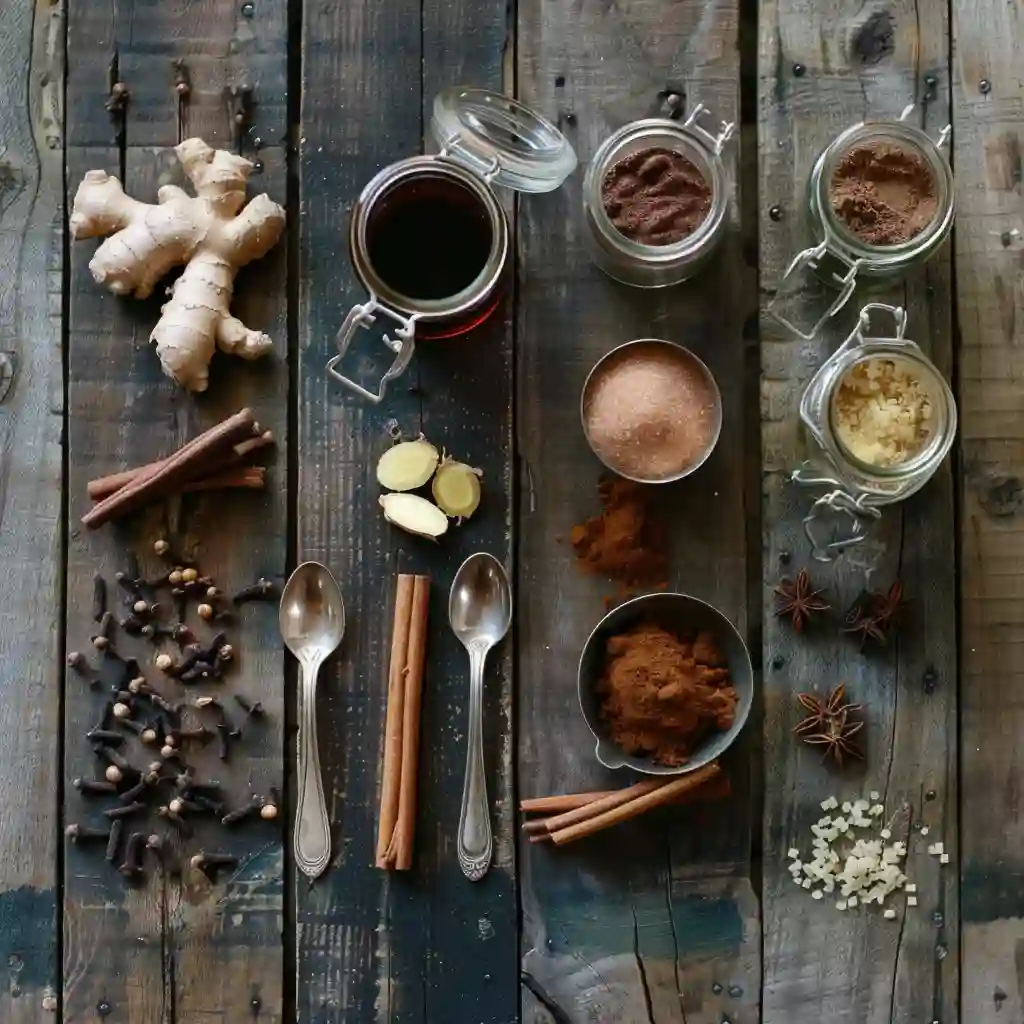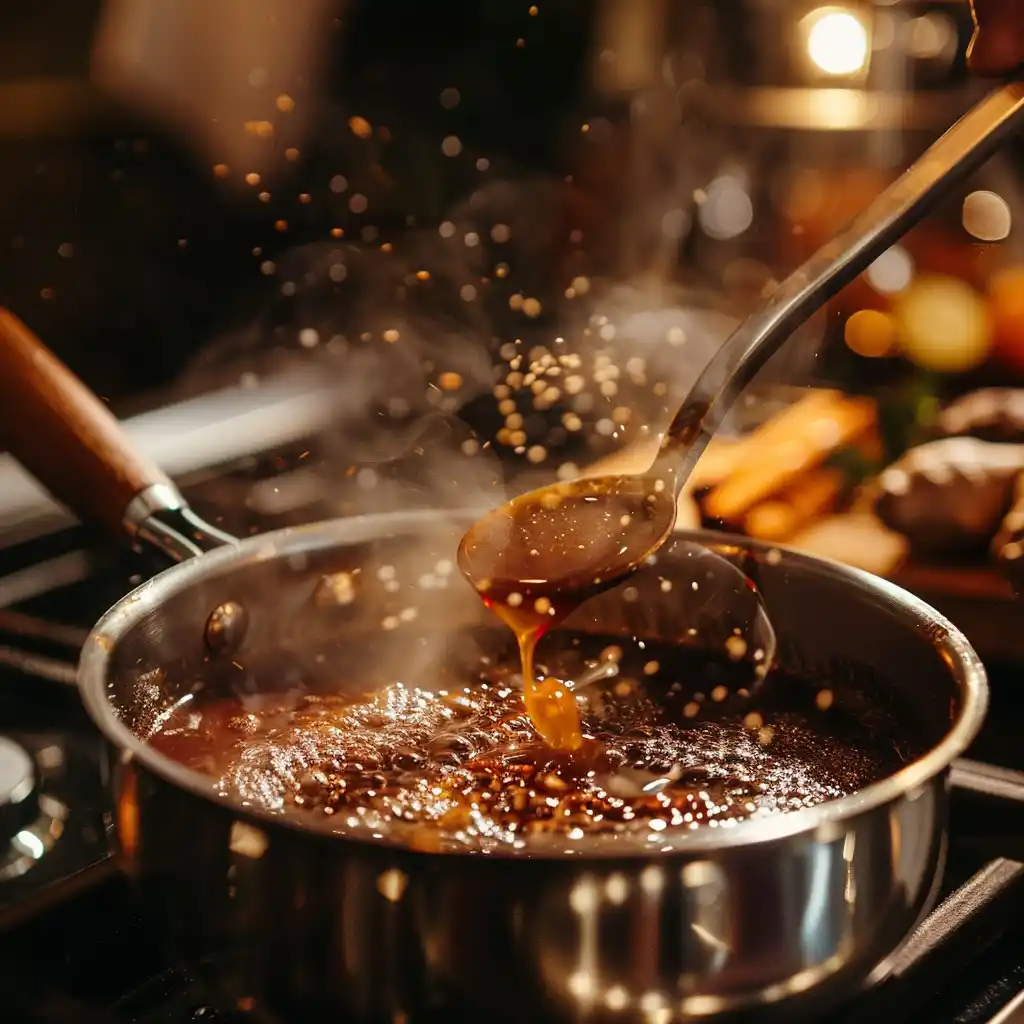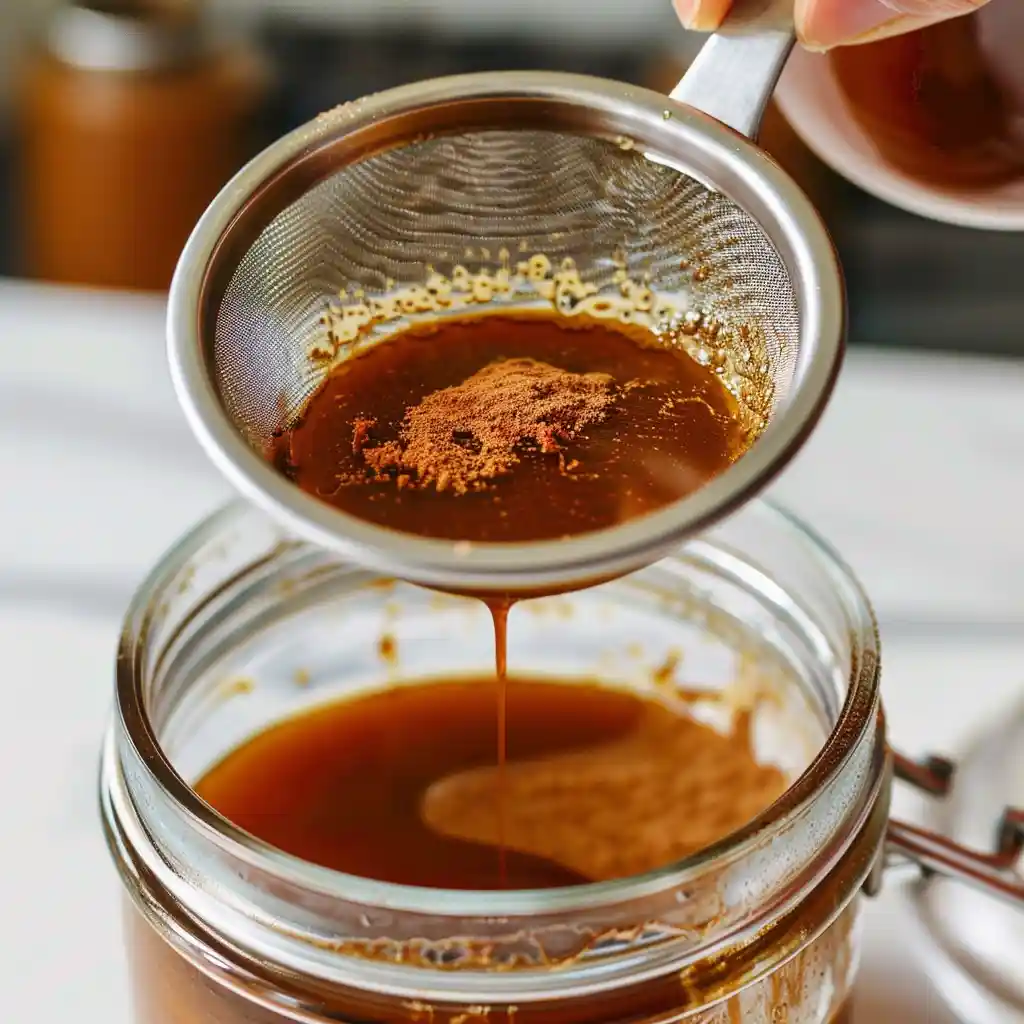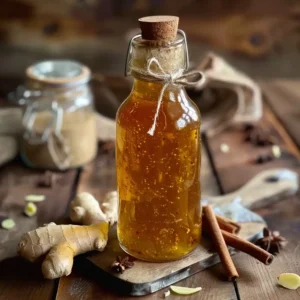I still remember the first time I made a homemade gingerbread syrup. It was a cold November morning, and I had just returned from a trip to Vermont where I tasted a gingerbread latte so comforting, I had to recreate it at home. But instead of relying on store-bought syrups, I reached for my spice rack. That day, with cinnamon, cloves, and fresh ginger in hand, I started a tradition that now fills my kitchen with the scent of holidays each year.
This article is your complete guide to making your own gingerbread syrup recipe—perfect for holiday drinks, lattes, pancakes, and more. Whether you’re a coffee lover, home mixologist, or simply love the warm flavors of gingerbread, this recipe is for you.
We’ll walk through the classic syrup method, explore Starbucks-style gingerbread syrup, cover the best ways to use and store it, and answer the most common questions like “What is the simple syrup formula?” and “What flavors are in gingerbread syrup?” We’ll even include healthier twists and creative serving ideas.
If you’re new to homemade syrups, don’t worry—this guide is super beginner-friendly. And if you’re here looking to upgrade your festive drinks, you’re in the right place. Looking for inspiration? Try our banana bread latte for a similar seasonal vibe.
Let’s get into the rich, spicy world of gingerbread syrup—your drinks (and desserts) are about to get a whole lot cozier.
Print
Gingerbread Syrup Recipe
A warm, spiced homemade gingerbread syrup perfect for lattes, pancakes, cocktails, and holiday treats. Full of festive flavor and made with real spices, it’s your go-to cozy syrup for winter.
- Total Time: 20 minutes
- Yield: 1 cup 1x
Ingredients
- 1 cup water
- 1 cup brown sugar (light or dark)
- 1 tablespoon molasses (optional but highly recommended)
- 1 tablespoon fresh grated ginger or 2 teaspoons ground ginger
- 1 teaspoon cinnamon
- 1/2 teaspoon cloves
- 1/4 teaspoon nutmeg
- 1 teaspoon vanilla extract (added after cooking)
Instructions
- In a small saucepan, combine water, brown sugar, molasses, ginger, cinnamon, cloves, and nutmeg. Stir well.
- Bring to a gentle boil over medium heat, stirring occasionally. Reduce heat and simmer for 10–15 minutes to thicken and deepen the flavor.
- Remove from heat and stir in vanilla extract.
- Let cool slightly, then strain the syrup through a fine mesh sieve or cheesecloth into a clean jar or bottle.
- Store in the refrigerator for up to 3 weeks. Makes approximately 1 cup of syrup.
Notes
To adjust thickness, simmer longer or use a 2:1 sugar-to-water ratio. Use whole spices for cleaner flavor and strain before storing. Delicious in coffee, tea, desserts, and cocktails.
- Prep Time: 5 minutes
- Cook Time: 15 minutes
- Category: Syrup
- Method: Stovetop
- Cuisine: American
- Diet: Vegan
Nutrition
- Serving Size: 1 tablespoon
- Calories: 50
- Sugar: 12g
- Sodium: 1mg
- Fat: 0g
- Saturated Fat: 0g
- Unsaturated Fat: 0g
- Trans Fat: 0g
- Carbohydrates: 13g
- Fiber: 0g
- Protein: 0g
- Cholesterol: 0mg
Introduction to Gingerbread Syrup
What is Gingerbread Syrup?
Gingerbread syrup is a sweet, spiced liquid that captures all the nostalgic flavors of the holidays—ginger, cinnamon, cloves, nutmeg, and molasses—boiled down into a pourable syrup you can use in your coffee, tea, pancakes, or cocktails. It’s the heart of any cozy drink during fall and winter, and once you taste it homemade, there’s no going back to artificial store-bought versions.
A good gingerbread syrup recipe brings warmth to every sip and bite. It transforms an ordinary latte into a café-style experience and makes breakfast feel like a treat. Whether you drizzle it over baked apples or stir it into your oat milk, the result is pure holiday comfort.
Why Make It at Home?
When you make your own gingerbread syrup recipe, you control every ingredient—from the type of sugar you use to how spicy you want it. Plus, it’s incredibly cost-effective compared to buying bottled syrups. You’ll also avoid unnecessary additives or artificial flavors.
Another benefit? The aroma. Simmering a gingerbread syrup on the stove fills your kitchen with the scent of fresh-baked cookies and cozy weekends. It’s not just a recipe—it’s a whole vibe.
Homemade syrups also make thoughtful, low-cost holiday gifts. Pair your gingerbread syrup with a cute mug, handwritten tag, and a cinnamon stick, and you’ve got something anyone would love.
Pro Tip: If you want your gingerbread syrup recipe to have a deeper, richer taste, add a tablespoon of molasses along with brown sugar for that unmistakable gingerbread depth.
The Classic Gingerbread Syrup Recipe
Essential Ingredients
Crafting the perfect gingerbread syrup recipe starts with the right blend of ingredients. You don’t need anything fancy—just a few pantry staples and about 15 minutes. The base is simple: water, sugar, and a handful of warm spices. Here’s what you’ll need:
- 1 cup water
- 1 cup brown sugar (light or dark)
- 1 tablespoon molasses (optional but highly recommended)
- 1 tablespoon fresh grated ginger or 2 teaspoons ground ginger
- 1 teaspoon cinnamon
- ½ teaspoon cloves
- ¼ teaspoon nutmeg
- 1 teaspoon vanilla extract (added after cooking)
This combo delivers that nostalgic gingerbread cookie flavor in syrup form. If you’re feeling adventurous, add a pinch of allspice or cardamom for extra complexity.

Pro Tip: Use whole spices like cinnamon sticks and whole cloves, then strain them out for a cleaner finish. It enhances the flavor without leaving grit.
Step-by-Step Instructions
- Combine the Ingredients: In a small saucepan, combine water, brown sugar, molasses, ginger, cinnamon, cloves, and nutmeg. Stir to blend everything together.
- Simmer Slowly: Bring the mixture to a gentle boil over medium heat, stirring occasionally. Once boiling, reduce heat and let it simmer for 10–15 minutes. This thickens the syrup and lets the flavors deepen.
- Finish with Vanilla: Remove from heat and stir in the vanilla extract. Let the syrup cool slightly.
- Strain and Store: For a smooth texture, strain the syrup through a fine mesh sieve or cheesecloth into a clean jar or bottle.

This classic gingerbread syrup recipe yields about 1 cup and lasts up to 3 weeks in the fridge. You can use it in everything from morning coffee to evening cocktails. Discover great ideas like our dirty soda recipes to experiment with different drink pairings.

Pro Tip: Want it thicker for desserts? Let it simmer a little longer or use a 2:1 sugar-to-water ratio. That’s a sweeter version of the simple syrup formula, ideal for drizzle-worthy consistency.
Gingerbread Syrup Variations
Ginger Syrup Recipe for Ginger Ale
Not all syrups need to scream “holiday.” A ginger syrup recipe for ginger ale is a fresh, zesty twist on the traditional gingerbread syrup recipe. This version ditches molasses and heavy spices in favor of bright, punchy ginger with citrus notes. It’s ideal for homemade ginger ale or mixing into sparkling water for a non-alcoholic, refreshing treat.
Here’s a quick version:
- 1 cup water
- 1 cup white sugar
- 2 tablespoons freshly grated ginger
- Juice of half a lemon
Simmer everything for 15 minutes, strain, and cool. Combine 2 tablespoons with chilled sparkling water and a squeeze of lime. While not as rich as a gingerbread syrup recipe, this light syrup still packs a warming zing.
Pro Tip: Add a few mint leaves while simmering for a mojito-style mocktail that surprises everyone.
Gingerbread Simple Syrup Recipe (1:1 & 2:1 Ratios)
Let’s talk ratios. A gingerbread simple syrup recipe can be adjusted depending on how you plan to use it. If you’re looking for something to stir into iced lattes or drizzle over waffles, a 1:1 ratio of sugar to water works perfectly—smooth, sweet, and easily pourable.
Want something richer and more concentrated? Go for a 2:1 ratio. That’s 2 parts sugar to 1 part water. It creates a thicker syrup that’s ideal for gifting, cocktails, or long-term storage.
No matter the ratio, what makes it a true gingerbread syrup recipe is the blend of spices: ginger, cinnamon, and clove are essential. You can tailor the heat by using more ginger or even add cracked peppercorns for a bolder kick.
Check out our homemade soda guide to see how these ratios can influence fizz and flavor in DIY drinks.
Pro Tip: If your syrup crystalizes in the fridge, warm it slightly or add a splash of corn syrup during cooking to prevent recrystallization.
Starbucks-Inspired Gingerbread Syrup Recipe
Flavor Breakdown of Starbucks Version
For many of us, the first time we tasted a gingerbread syrup recipe might’ve been from Starbucks during the holidays. Their version is iconic—warm, sweet, and cozy with subtle vanilla and spice. It’s designed to blend seamlessly into espresso, steamed milk, and cold brews without overpowering them.
The flavor profile? Think brown sugar, cinnamon, clove, ginger, a touch of nutmeg, and a smooth vanilla finish. It’s not overly molasses-heavy, which makes it perfect for those who like a gentler spice.
Pro Tip: Use light brown sugar for a mellow base, and go easy on the clove—it can dominate the flavor if you’re not careful.
Homemade Copycat Recipe
To recreate the Starbucks-style gingerbread syrup recipe at home, follow this variation:
- 1 cup water
- ¾ cup light brown sugar
- 1 tablespoon molasses
- 1 tablespoon grated fresh ginger
- 1 teaspoon cinnamon
- ¼ teaspoon clove
- Pinch of nutmeg
- 1½ teaspoons vanilla extract (added after boiling)
Bring everything except the vanilla to a simmer for about 12 minutes. Then remove from heat, stir in the vanilla, and let it cool. Strain into a bottle and refrigerate.
This copycat gingerbread syrup recipe is smoother and more coffee-friendly than bolder versions. Add 2 tablespoons to your latte or drizzle over French toast. You’ll get that café-style taste at a fraction of the cost.
Don’t miss our natural gatorade recipe for another example of a homemade drink syrup that skips artificial ingredients.
Pro Tip: Want a dairy-free gingerbread latte? Use oat milk or almond milk—the spices pair beautifully with plant-based creaminess.
Creative Ways to Use Gingerbread Syrup
Holiday Coffee and Lattes
The most popular use for a gingerbread syrup recipe is, of course, coffee. Just one or two tablespoons added to espresso or brewed coffee turns your cup into a festive treat. Pair it with steamed milk for a cozy gingerbread latte or mix it into cold brew for an iced version. Even tea lovers can enjoy it—try adding a splash to chai for a sweet-spicy twist.
If you’re entertaining guests, set up a DIY gingerbread latte bar with syrups, whipped cream, and cinnamon sticks. It’s a fun, easy way to make everyone feel special.
Pro Tip: Add a dash of sea salt on top of your whipped cream for a salted caramel-style gingerbread latte.
Desserts and More
While drinks are the obvious place to start, don’t limit your gingerbread syrup recipe to just beverages. This syrup works magic on desserts too. Drizzle it over pancakes, waffles, vanilla ice cream, or baked pears for an instant holiday upgrade. You can even stir it into frosting for cupcakes or brush it on sponge cakes as a flavorful soak.
One of my favorite uses? Swirling it into oatmeal on a cold morning. It transforms the bowl into something that tastes like a gingerbread cookie in breakfast form. You might also enjoy adding it to plain Greek yogurt with granola.
Check out our fermented garlic honey for another unique syrup-style infusion that pairs sweet with savory in surprising ways.
Pro Tip: Mix the syrup with a little melted butter and use it as a glaze for roasted carrots or sweet potatoes. It’s sweet, spicy, and totally unexpected.
Storing and Preserving Your Syrup
How to Store Gingerbread Syrup
Once you’ve made your homemade gingerbread syrup recipe, the next step is proper storage. This ensures the syrup stays fresh, flavorful, and safe to use for weeks. The best option is to pour the cooled syrup into a clean glass jar or bottle with a tight-fitting lid. Store it in the refrigerator, where it can last up to 3 weeks without any flavor loss.
If you’re making a big batch, consider labeling the jar with the date you made it. This is especially helpful during the holiday season when you may have multiple homemade goodies lined up.
Pro Tip: Sterilize your bottle before filling it with syrup to extend its shelf life naturally—just rinse with boiling water and let air dry.
Freezing for Later Use
For longer-term storage, freezing your gingerbread syrup recipe is a smart move. Simply pour it into silicone ice cube trays and freeze. Once solid, transfer the cubes into a freezer-safe bag. This makes it super convenient to grab a portion-sized cube whenever you’re making a drink or dessert.
Each frozen cube can be dropped into hot coffee, melted for pancake topping, or used in baking. Freezing also helps prevent waste if you only use syrup occasionally.
Looking for more ways to infuse flavor into your creations? Try our white peach sangria for another way to preserve seasonal taste in liquid form.
Pro Tip: If you notice sugar crystallization while storing your syrup, reheat it gently and stir to dissolve the crystals—avoid microwaving as it may alter flavor.
Healthier Alternatives and Adjustments
Low Sugar and Vegan Options
One of the joys of making your own gingerbread syrup recipe is how flexible it can be. If you’re watching your sugar intake or prefer plant-based ingredients, there are easy tweaks that still deliver on flavor. Instead of using regular brown sugar, try coconut sugar or maple syrup. Both options add a rich depth and a touch of caramel that fits perfectly with gingerbread spices.
For a vegan-friendly version, avoid honey and stick with natural sweeteners like agave nectar. The result? A syrup that’s gentle on your diet but still cozy and indulgent.
Pro Tip: Coconut sugar makes the syrup slightly less sweet but adds a toasty finish. Start with a 1:1 ratio and adjust based on your taste.
Spice Adjustments Based on Preference
Another reason to love a homemade gingerbread syrup recipe is the freedom to adjust spices to your liking. Some people prefer a bold ginger kick, while others want more cinnamon or a mild clove background. There’s no rulebook—this is your flavor story to write.
If you’re unsure, start with small amounts and build up. Taste as you simmer. Want to tone down the spice for kids? Reduce the ginger and add a touch more vanilla. Craving something complex? A pinch of black pepper or cardamom adds an unexpected twist.
This kind of flexibility is what makes DIY syrups so satisfying—and it’s why more and more people are turning to homemade recipes over store-bought versions.
Pro Tip: Always test your spice blend in a small batch first. Once you find your ideal combo, scale it up for gifts or weekly prep.
Troubleshooting Common Issues
Too Thin or Too Thick?
Sometimes when making a gingerbread syrup recipe, you’ll find the texture isn’t quite right. If your syrup ends up too thin, it may not cling well to pancakes or mix smoothly into coffee. This usually means it didn’t simmer long enough. Just return it to the stove and cook for a few more minutes until it reaches a slightly thicker consistency.
On the flip side, if your syrup is too thick or sticky, don’t panic. A tablespoon or two of warm water stirred in can loosen it up without diluting the flavor. Stir slowly until it’s smooth again.
Pro Tip: Simmer syrup on low heat—rushing the process can cause uneven thickness or burned sugar at the bottom of the pan.
Flavor Too Strong or Too Mild?
Taste is personal, and even the best gingerbread syrup recipe may need small tweaks to fit your preferences. If it’s too spicy or strong, add a splash of vanilla or increase the sugar slightly to mellow things out. If it’s too bland, increase the ginger or cinnamon by a quarter teaspoon next time.
Remember, spices become more pronounced as the syrup sits, so it’s always a good idea to let it cool before judging the final flavor. For the bold at heart, adding citrus zest or a few black peppercorns during simmering adds a deeper bite.
Pro Tip: Write down your changes each time so you can perfect your personal recipe over time. Syrup-making is part science, part memory.
Bottling for Gifts and Holiday Gifting Ideas
Cute Bottling Ideas
If you’ve mastered your homemade gingerbread syrup recipe, why not share the love? Bottling your syrup turns it into a thoughtful and affordable holiday gift. Small glass bottles with swing-top lids or mini mason jars make great vessels. Look for 4 to 8-ounce sizes—they’re just right for gifting and easy to store in the fridge.
For a rustic touch, tie a ribbon or twine around the lid and add a small cinnamon stick or star anise. It’s a festive detail that gives your gift personality without being expensive.
Pro Tip: Always label your bottle with the syrup name, date made, and suggested use—your friends will appreciate the instructions.
Gift Tag Tips and Recipe Cards
The best part of gifting your gingerbread syrup recipe is watching someone enjoy it with their morning coffee or dessert. Add a handwritten recipe card or usage ideas to the bottle: “Delicious in lattes, drizzled on pancakes, or stirred into oatmeal.” This small touch makes your gift personal, practical, and memorable.
Don’t forget to mention storage instructions too: “Keep refrigerated. Use within 3 weeks.” It’s helpful for anyone who might not be used to homemade syrups.
If you’re gifting to a group, make a batch and divide it among several jars. Pair the syrup with a cute mug, holiday cookie, or even a coffee sachet for a sweet DIY gift basket.
Pro Tip: Make it a family project—kids can help with pouring, labeling, or decorating. It’s a creative way to get everyone involved in meaningful holiday giving.
Frequently Asked Questions About Gingerbread Syrup
What is the simple syrup formula?
The basic formula for simple syrup is a ratio of sugar to water—typically 1:1. This creates a liquid sweetener that’s easy to mix into cold or hot drinks. However, when making a gingerbread syrup recipe, many people prefer a 2:1 ratio (two parts sugar to one part water) for a thicker, longer-lasting syrup with more flavor punch.
What flavors are in gingerbread syrup?
A traditional gingerbread syrup recipe combines warm spices like ginger, cinnamon, cloves, and nutmeg with sweeteners such as brown sugar or molasses. Some versions also include vanilla extract for balance and depth. These flavors work together to mimic the nostalgic taste of a gingerbread cookie in liquid form.
How do you make ginger syrup for pancakes?
To make a simple ginger syrup for pancakes, combine equal parts sugar and water with fresh grated ginger. Simmer for about 15 minutes, then strain. If you’re craving something more holiday-themed, you can upgrade this into a gingerbread syrup recipe by adding cinnamon, cloves, and a dash of molasses. It pairs perfectly with pancakes, waffles, or even French toast.
Is simple syrup 2 to 1 or 1 to 1?
Both ratios are correct—it depends on the use. A 1:1 syrup is thinner and easier to mix into drinks, while a 2:1 syrup is thicker and lasts longer in the fridge. For a richer gingerbread syrup recipe, the 2:1 ratio is often preferred, especially when gifting or using it in desserts that need a stronger flavor.
Pro Tip: If you’re making a 2:1 syrup, stir slowly while heating to make sure all the sugar dissolves evenly without burning.
Conclusion: The Cozy Joy of Homemade Gingerbread Syrup
Making your own gingerbread syrup recipe is more than just mixing spices and sugar—it’s a way to bring warmth and nostalgia into your kitchen. With just a few pantry staples, you can create a versatile syrup that enhances everything from lattes to desserts and even makes a thoughtful holiday gift.
Throughout this guide, we’ve explored different recipe variations, troubleshooting tips, and creative uses to help you craft a syrup that fits your taste and lifestyle. Whether you prefer a rich Starbucks-style version or a lighter ginger syrup for ginger ale, the power is in your hands to tweak and make it your own.
If you’ve enjoyed this journey into cozy flavors, don’t miss our banana bread latte and dirty soda recipes for even more inspiration. These drink ideas pair beautifully with your homemade syrup creations.
Pro Tip: Share your finished syrup on social media or package it as a gift—it’s a personal, homemade touch that brings smiles every time.
This recipe is shared for informational purposes and is not a substitute for medical advice. For more creative ideas, follow us on Facebook or check out our latest flavor experiments on Pinterest.







